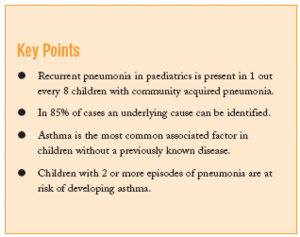Pneumonia is defined as the presence of fever and respiratory symptoms together with radiological evidence of parenchymal infiltrate. It is a problem of great magnitude in paediatrics, as it preferentially affects children less than 5 years old. It causes more than 4 million deaths per year, particularly in developing countries. In Spain, community acquired pneumonia (CAP) has an incidence of 4%-6% per year in children.1 In other areas and incidence of CAP of 6.7%-7.4% has been reported in pre-school age children, of which 6.9%-8.2% had recurrent pneumonia (RP).2 According to other authors, up to 8% of children with pneumonia can present with RP.3
RP is defined as 2 or more episodes of pneumonia in 1 year or a total of 3 or more episodes throughout life, with normal radiology between episodes.4 An aetiological study should be started on any child who presents with acquired RP, to identify underlying causes which might not be known at the time of the diagnosis.
Most of the studies which look at the causes of RP come from series of hospitalised children, and the diseases most frequently found differ, depending on the authors consulted. On many occasions, the underlying disease, previous to the pneumonia, is known (80.9%), in others it is discovered during the first episode (11.4%), and less frequently the causal diagnosis is made after the RP (7.7%). The
disease processes which tend to be present before the first pneumonia are: bronchial aspiration, immunodeficiency, and congenital cardiac disease, while asthma, abnormalities of the respiratory tract and gastroesophageal reflux are those which are discovered after the first pneumonia or in RP.3
In another series of patients studied for RP, the most frequently found underlying disease processes were: asthma in 32%, gastro-oesophagus reflux in 15%, disease of the immunological system in 9%, lung and thoracic abnormalities in 6% and bronchopulmonary dysplasia in 4%, cystic fibrosis in 3%, tuberculosis in 3%, aspiration syndrome in 3%, and 15% with no identifiable cause. In children less than 1 year, gastroesophageal reflux is the most frequent underlying process and in those over 2 years old, asthma.5
As a conclusion it could be pointed out that after an appropriate investigation the causal diagnosis of RP can be arrived at in 85% of cases. When there is no previous diagnosis, asthma and gastroesophageal reflux should be actively investigated.
From the studies mentioned the great importance of asthma emerges as a background disease in the child with RP. However the role of recurrent pneumonia as a risk factor for the development of childhood asthma has not been sufficiently studied. The work of Picas et al6 makes an interesting contribution in this direction, since it tries to determine if acquired RP in the community is a risk factor for the development of childhood asthma (CA) as compared to the presence of only one episode of pneumonia, non-recurrent pneumonia (NRP), as well as determining if patients with CA are more predisposed to present with RP.
It must be emphasised that this study deals with children studied as out-patients of a health centre and that none of them required hospitalisation, while the majority of studies on RP come from hospital series. They recorded 80 episodes of CAP in 65 children <15 years old (mean age, 52.8 months) over a period of 3 and a half years.1 It excluded hospitalised children and those with previously known diseases. It should be pointed out that the definition criteria for RP has been less strict than that used by other authors,4 since it has considered that RP is present in all children diagnosed with more than one episode of pneumonia during the period of the study.
The frequency of RP found among children who had a previous CAP is 27.7%, a figure higher than that reported by other authors (6.7%-7.4% and 8%)2,3; this fact can be explained by several factors; the diagnostic criteria to define RP is less strict than that used in other publications, the fact that they were out-patients, considering that only 10% of children with pneumonia require hospitalisation, as well as the sample size.
The present study has been able to detect that RP was associated with previously undiagnosed CA, as compared to the presence of NRP (RR=4.1; 95% CI, 1.9-8.9; P=.002), while no significant differences were found between RP and NRP in children previously diagnosed with CA (RR=1.28; 95% CI, 0.5-3.0; P=.6).
This data is of special interest, since it demonstrates the strong association between RP and CA in children <15 years in primary care, while no association was found between previously diagnosed CA and RP.
Up until now, the factors associated with the prevalence of bronchial asthma in children and adolescents are: to be male, family history of asthma, rhinitis symptoms, respiratory infections, need to exclude any food from the diet, and wheezing or cough with exercise.7
In primary care, the direct application of these findings is that children who present with RP, without previously known diseases, are a "high risk population" for the subsequent development of CA.
It is essential to concentrate diagnostic efforts, treatment and prevention directed at all children who present with acquired RP in the community, without previously known underlying diseases, due to the risk of subsequently developing CA.
It would be of great value to perform future prospective, multi-centred studies, carried out from primary care, to obtain more accurate data which could increase the value of the strength of association described.








